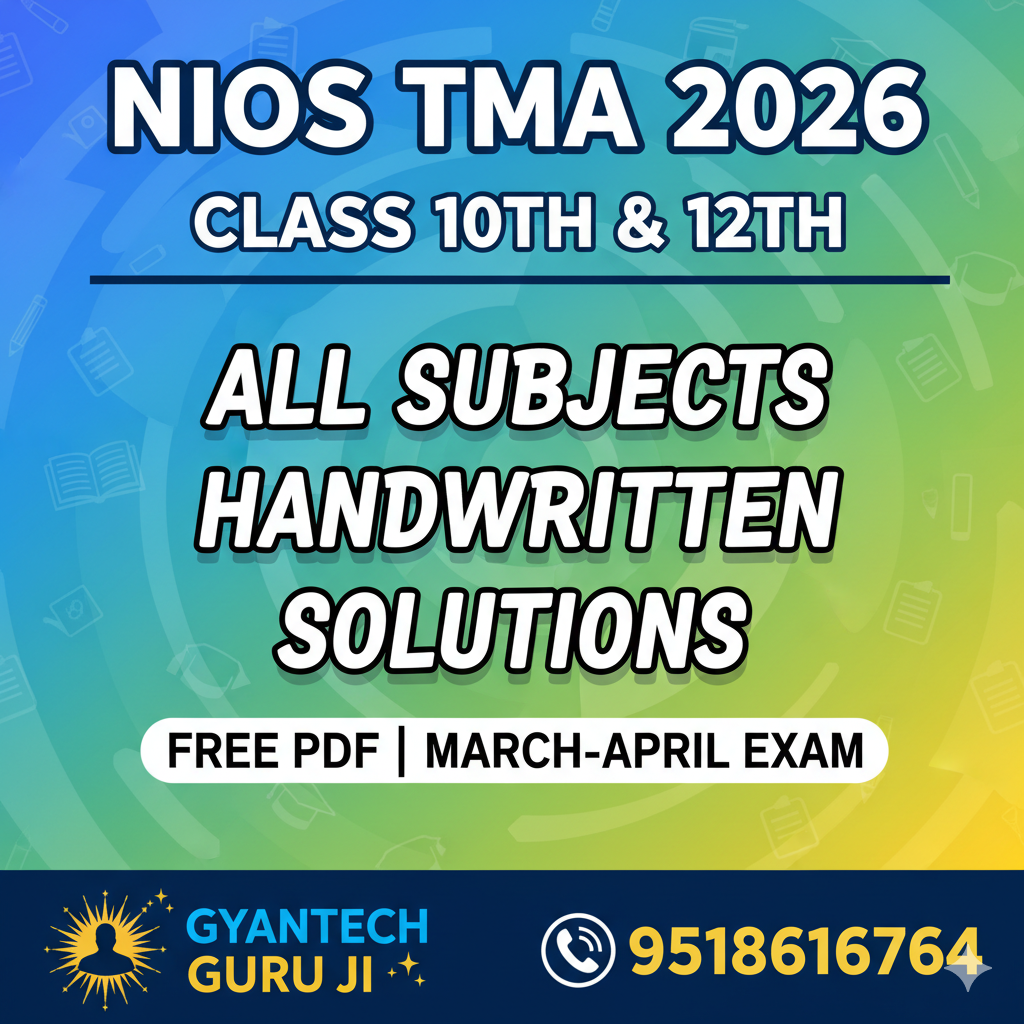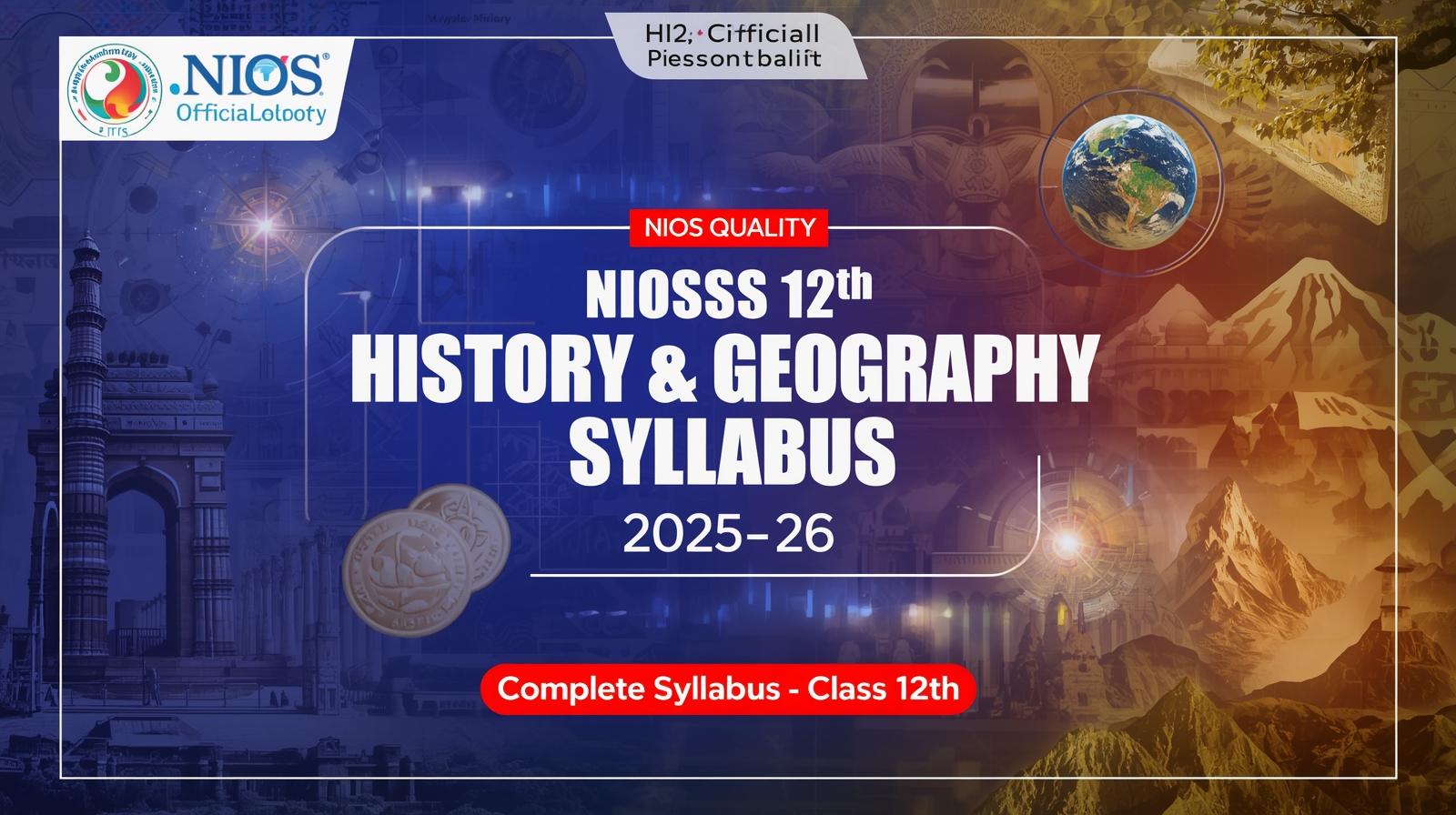NIOS Class 12th PCM Syllabus for 2025-26 by GyanTech Guruji
For official and latest details, please visit the NIOS Official Website. This page provides a comprehensive overview of the Physics, Chemistry, and Mathematics syllabi for NIOS Class 12th for the academic year 2025-26, including module breakdowns, question paper designs, weightages, and difficulty levels.
NIOS Class 12 Physics Syllabus 2025
The NIOS Class 12 Physics syllabus for 2025–2026 comprises 30 lessons, divided into two main parts. The syllabus is structured with 40% (12 lessons) allocated to the Tutor Marked Assignment (TMA) and 60% (18 lessons) to the Public Examination. Further details regarding the syllabus modules can be found below the table.
Modules
| MODULE (No. & name) | (No. of lessons-12) | (No. of lessons-18) |
|---|---|---|
| 1. Force and Energy | L-1 (Units Dimensions and Vectors) L-2 (Motion in a Straight Line) L-4 (Motion in a Plane) L-5 (Gravitation) L-7 (Motion of a Rigid Body) | L-3 (Laws of Motion) L-6 (Work, Energy and Power) |
| 2. Mechanics of Solids and Fluids | L-8 (Elastic Properties of Solids) | L-9 (Properties of Fluids) |
| 3. Thermal Physics | L-10 (Kinetic Theory of Gases) L-12 (Heat Transfer and Solar Energy) | L-11 (Thermodynamics) |
| 4. Oscillations and Waves | L-13 (Simple Harmonic Motion) | L-14 (Wave Phenomena) |
| 5. Electricity and Magnetism | - | L-15 (Electric Charge and Electric Field) L-16 (Electric Potential and Capacitors) L-17 (Electric Current) L-18 (Magnetism and Magnetic Effect of Electric Current) L-19 (Electromagnetic Induction and Alternating Current) |
| 6. Optics and Optical Instruments | L-20 (Reflection and Refraction of Light) L-23 (Optical Instruments) | L-21 (Dispersion and Scattering of Light ) L-22 (Wave Phenomena and Light) |
| 7. Atoms and Nuclei | - | L-24 (Structure of Atoms) L-25 (Dual Nature of Radiation and Matter) L-26 (Nuclei and Radioactivity) L-27 (Nuclear Fission and Fusion) |
| 8. Semiconductor Devices and Communication | L-30 (Communication System) | L-28 (Semiconductors and Semiconducting Devices) L-29 (Applications of Semiconductor Devices) |
NIOS Class 12 Physics Question Paper Design
Weightage by Objectives
| Objective | TOTAL | % of the total marks |
|---|---|---|
| Knowledge | 20 | 25% |
| Understanding | 40 | 50% |
| Application | 20 | 25% |
| Total | 100 | 100% |
Weightage by Type of Questions
| Types of questions | No. Of questions | Total marks |
|---|---|---|
| MCQ (1 mark) | 16 | 16 |
| Objective Type Questions (1*2 = 2 marks) (with 2 sub-parts of 1 mark each) [Fill in the blanks, match the column, paragraph or case-based questions, one-word questions, True False, etc.] | 12 | 24 |
| Total (Objective) | 28 | 40 |
| Very Short Answer (2 marks) | 9 | 18 |
| Short Answer (SA) (3 marks) | 4 | 12 |
| Long Answer (LA) (5 marks) | 2 | 10 |
| Total (Subjective) | 15 | 40 |
| Grand Total | 43 | 80 |
In subjective questions: 4 Questions of 2 marks (VSA), 2 Questions of 3 marks (SA), 2 Questions of 5 marks (LA) will have internal choices.
Weightage by Contents
| Modules | Marks |
|---|---|
| Motion Force and Energy | 14 |
| Mechanics of solid and Fluid | 06 |
| Thermal Physics | 06 |
| Oscillation and Wave | 06 |
| Electricity and Magnetism | 16 |
| Optics and Optical Instruments | 14 |
| Atoms and Nuclei | 08 |
| Semiconductor Devices and Communication | 10 |
| Total | 80 |
Difficulty Level of the Question Paper
| Estimated Level | Marks | Percentage of marks |
|---|---|---|
| Difficulty | 16 | 20% |
| Average | 40 | 50% |
| Easy | 24 | 30% |
| Total | 80 | 100% |
NIOS Class 12 Mathematics Syllabus 2025
NIOS Class 12 Mathematics Syllabus will contain 38 lessons with distribution of marks. For complete details check the table below.
Modules
| MODULE | I TMA (40 % of Syllabus) - 15 lessons | II Public Examination (60% of syllabus) - 23 Lessons |
|---|---|---|
| Module-I Sets, Relations and Functions | 1. Sets 2. Relations and Functions-I 3. Trigonometric Functions-I 4. Trigonometric Functions-II 5. Relation between Sides and Angles of A triangle |
|
| Module-II Sequences and Series | 6. Sequences and Series 7. Some Special Sequences |
|
| Module-III Algebra-I | 8. Complex Numbers 9. Quadratic Equations and Linear Inequalities 10. Principle of Mathematical Induction 11. Permutations and Combinations 12. Binomial Theorem |
|
| Module-IV Co-ordinate Geometry | 13. Cartesian System of Rectangular Coordinates 14. Straight Lines 15. Circles |
16. Conic Sections |
| Module-V Statistics and Probability | 17. Measures of Dispersion 18. Random Experiments and Events 19. Probability |
|
| Module-VI Algebra-II | 20. Matrices 21. Determinants 22. Inverse of a Matrix and its Applications |
|
| Module-VII Relations and Functions | 23. Relations and Functions-II 24. Inverse Trigonometric Functions |
|
| Module-VIII Calculus | 25. Limits and Continuity 26. Differentiation 27. Differentiation of Trigonometric functions 28. Differentiation of Exponential and Logarithmic functions 29. Application of Derivatives 30. Integration 31. Definite Integrals 32. Differential Equations |
|
| Module-IX Vectors and Three Dimensional Geometry | 33. Introduction to Three Dimensional Geometry 34. Vectors 35. Plane 36. Straight Line |
|
| Module-X Linear Programming and Mathematical Reasoning | 37. Linear Programming 38. Mathematical Reasoning |
Question Paper Design
1. Weightage by Objectives
| Objective | Marks | Percentage |
|---|---|---|
| Knowledge | 30 | 30% |
| Understanding | 40 | 40% |
| Application | 22 | 22% |
| Skill | 8 | 8% |
2. Weightage by Type of Questions
| Type of question | No. of questions | Marks |
|---|---|---|
| MCQ (1 mark) | 20 | 20 |
| Objective Type Questions (1*2 = 2 marks) (with 2 sub-parts of 1 mark each) | 4 | 8 |
| Objective Type Questions (1*4 = 4 marks) (with 4 sub-parts of 1 mark each) | 4 | 16 |
| Objective Type Questions (1*6 = 6 marks) (with 6 sub-parts of 1 mark each) | 1 | 6 |
| Total (Objective) | 29 | 50 |
| Very Short Answer (2 marks questions) | 9 | 18 |
| Short Answer (SA) (4 marks questions) | 5 | 20 |
| Long Answer (LA) (6 marks questions) | 2 | 12 |
| Total (Subjective) | 16 | 50 |
| Grand Total | 45 | 100 |
In subjective questions: 4 Questions of 2 marks (VSA), 2 Questions of 3 marks (SA), 2 Questions of 6 marks (LA) will have internal choices.
3. Weightage to the Difficulty Level of the Question
| Estimated Level | Marks | Percentage of marks |
|---|---|---|
| Difficulty | 20 | 20% |
| Average | 50 | 50% |
| Easy | 30 | 30% |
| Total | 100 | 100% |
4. Weightage by Content
| Topics | Marks |
|---|---|
| Co-ordinate Geometry | 15 |
| Algebra-II | 17 |
| Relations and Functions | 12 |
| Calculus | 30 |
| Vectors and Three Dimensional Geometry | 17 |
| Linear Programming and Mathematical Reasoning | 9 |
| Total | 100 |
NIOS Class 12th Chemistry Syllabus for 2025-26
The NIOS Class 12 Chemistry syllabus for 2025–2026 comprises 32 lessons, divided into two main parts. The syllabus is structured with 40% (12 lessons) allocated to the Tutor Marked Assignment (TMA) and 60% (20 lessons) to the Public Examination. Further details regarding the syllabus modules can be found below the table.
Modules
| MODULE | (12 lessons) | (20 lessons) |
|---|---|---|
| Module I Some Basic concepts of Chemistry | Lesson-1 (Atoms, Molecules and Chemical Arithmetic) | |
| Module II Atomic Structure and Chemical Bonding | Lesson-3(Periodic Table and Periodicity in Properties) | Lesson-2 (Atomic Structure) Lesson-4(Chemical Bonding) |
| Module III States of Matter | Lesson-5 (The Gaseous State and Liquid State) | Lesson-6 (The Solid State) Lesson-8 (Colloidal) Lesson-7(Solutions) |
| Module VI Chemical Energetics | Lesson-10 (Spontaneity of Chemical Reactions) | Lesson-9(Chemical Thermodynamics) |
| Module V Chemical Dynamics | Lesson-11 (Chemical Equilibrium) Lesson-14 (Chemical Kinetics) Lesson-15 (Adsorption and Catalysis) |
Lesson-12(Ionic Equilibrium) Lesson-13(Electrochemistry) |
| Module VI Chemistry of Elements | Lesson 16 (Occurrence and Extraction of Metals) | Lesson-17 (Hydrogen and s-Block Elements) Lesson-18 (General Characteristics of p-Block Elements) Lesson-20 (p-Block Elements and their Compounds-II) Lesson-21 d-Block and f-Block Elements Lesson-22 ( Coordination Compounds) |
| Module VII Chemistry of Organic Compounds | Lesson-23 (Nomenclature and General Principles) Lesson-24 (Hydrocarbons) Lesson-25 (Compounds of Carbon Containing Halogens) Lesson-26 (Alcohols, Phenols and Ethers) Lesson-27 (Aldehydes, Ketones and Carboxylic Acids) Lesson-28 (Compounds of Carbon Containing Nitrogen) Lesson-29 (Biomolecules) |
|
| Module VIII Chemistry in Everyday Life | Lesson-30(Drugs and Medicines) Lesson -32(Environmental Chemistry) |
Lesson-31 (Soaps, Detergents and Polymers) |
NIOS Class 12th Chemistry Sample Paper 2025-26
NIOS Class 12 Chemistry Sample Paper PDF - Download Here (Official Link)
NIOS Class 12 Chemistry Question Paper Design
Weightage by Objectives
| Objective | TOTAL | % of the total marks |
|---|---|---|
| Knowledge | 20 | 25% |
| Understanding | 36 | 45% |
| Application | 24 | 30% |
| Total | 80 | 100% |
Weightage by Type of Questions
| Forms of Questions | No. of Question | Total Marks |
|---|---|---|
| Objective Type Questions 1 Marks MCQ | 16 | 16 |
| 2×12=24 Marks Objective type | 12 | 24 |
| Total (Objective) | 28 | 40 |
| Very Short Answer (VSA) - 2 marks | 9 | 18 |
| Short Answer (SA) - 3 marks | 4 | 12 |
| Long Answer (LA) - 5 marks | 2 | 10 |
| Total (Subjective) | 15 | 40 |
| Grand Total | 43 | 80 |
Weightage by Contents
| Module | Marks |
|---|---|
| Some Basic Concepts of Chemistry | 04 |
| Atomic Structure and Chemical Bonding | 10 |
| States of Matter | 08 |
| Chemical Energetics | 06 |
| Chemical Dynamics | 12 |
| Chemistry of Elements | 18 |
| Chemistry of Organic Compounds | 18 |
| Chemistry in Everyday Life | 04 |
| Total | 80 |
Difficulty Level of the Question Paper
| Estimated Level | Marks | Percentage of marks |
|---|---|---|
| Difficulty | 16 | 20% |
| Average | 40 | 50% |
| Easy | 24 | 30% |
| Total | 80 | 100% |




